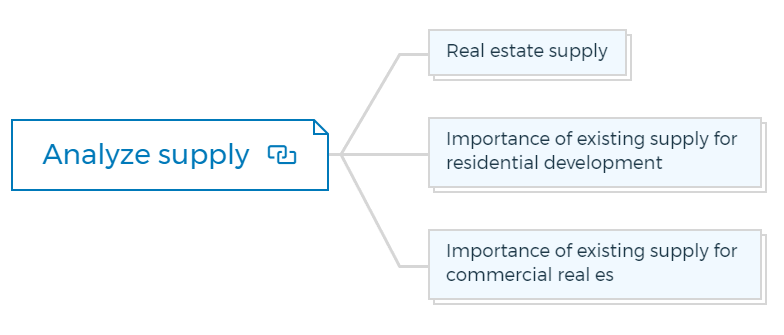Continued from…
Real Estate Market Analysis In 13 Easy Steps [Part 1-2]
Step 6 - Perform complex market study
You might want to figure out the regional facts that define the potential market. Geographic Information Systems (GIS) is the latest tool that you can use for more complex market area research.
These systems can include any database that can indicate a geographic location or spatial dimension for the variables.
GIS would almost certainly discover important insights for similar project studies in any modern market area investigation. Aside from the geographic location of a perceived market, additional market assessments may be required.
Here are some guidelines
- Determine the region not just in terms of geography but also in terms of where the market is located.
The market area for tenants can include both the immediate neighbourhood and adjacent areas. For example, this could be related to employment placement and access to transit lines in residential real estate projects.
- The study of any project should take into account how the new project may affect existing projects.
Be mindful of the distinctions between artificial boundaries (county lines, state borders, etc.) and built limits (freeways, etc.) that define or restrict a market region.
Be aware of the historical patterns of development that are based on cultural or ethnic ties. While these boundaries may change over time and evolve, they remain remarkably constant.
Make cautious assumptions about the optimum scale of development or the size of an existing market region based on unverified assumptions. It is crucial to examine the initial assumptions critically and test the conclusions.
You are missing out if you haven’t yet subscribed to our YouTube channel.
Step 7 - Site evaluation
The characteristics of one location differ significantly from those of another, and the explanations are not always clear.
The characteristics of a region have an impact on the conclusions. An interstate highway, a major border crossing, or employment patterns in one city or region, will have a substantial impact on your market analysis.
This leads to the significant real estate market analysis step, which is a more detailed site assessment.
What’s includes in the site evaluation?
Physical variables such as terrain, land shape, adjacent usage, and proximity to essential services should all be compared from site to site in a site evaluation.
Comparative analysis allows you to evaluate a specific property or a set of potential sites while keeping certain attributes in mind.
A shopping mall near a freeway exit would, of course, have more potential than one located outside of the city limits and away from the visibility of potential shoppers, the ease of access via roads and transit stations and the overall practicality of placing a shopping mall on well-travelled routes.
When comparing residential properties, local transit and proximity to amenities such as schools and retail are essential factors to consider. The analyst must walk the site, even if it may seem obvious to some.
Step 8 - Zoning
The issue of zoning should not be disregarded while doing a site examination. We can’t just assume that a rezone will automatically be granted because the land has been purchased for a specific purpose.
Lower-priced property may be so priced because of its current zoning, and local governments (not to mention individuals living nearby) are unlikely to support a rezone solely for the convenience of development interests (and profit).
On the other hand, if the new project will benefit the community and local government through more significant tax revenues, rezoning approval may be pretty easy to get.
One risk aspect in the site appraisal is the possible complications of investing in the land when zoning issues develop. You may need to compare undervalued but possibly lucrative land to more prominent locations.
Although the cost of already-zoned commercial land is likely to be higher, the likelihood of public anti-growth campaigns or refusal of rezoning applications by local governments is greatly reduced when zoning concerns are not discussed.
It’s critical to review state and municipal regulations beyond zoning for site appraisal. The zoning is worthless if you won’t get approval for your project due to GMA regulations because the site is outside the UGA.
As a prerequisite for approval, growth management regulations may require you to demonstrate the need for the development you propose.
For instance, you may need to assess a site in the context of a county’s inventory of land with similar zoning. How much of that land has been developed and is in use?
In GMA states, you may need to limit your site evaluation to available property within the existing urban perimeter or be prepared to show the need for your development outside that border.
How To Finance Your Property Development Project?
And Other Books On Real Estate Development Finance
Includes 5 x detailed eBooks
✓ Property Development Finance: Easily Finance Your Project? (26 Pages)
✓ 10 Big (Financial) Property Investing Mistakes Made By Investors (58 Pages)
✓ 10 Finance Options For Your Next Property Development Project (29 Pages)
✓ What Is Equity Finance And How Does It Work? (42 Pages)
✓ Property Investment Finance - Ultimate Guide
Step 9 - Analyze demand

Economic demand
Consumers need and want more of a commodity or type of outlet (shopping centres, apartments, houses, etc.) or when that demand is likely to follow if and when the development occurs.
For example, a hamlet may be 60 miles from the nearest large-scale regional mall. The lack of such a mall in town does not indicate a lack of demand. If such a facility was to be created, it is logical to assume that shoppers would arrive immediately rather than going 60 miles.
As a result, a demand analysis must contain understanding and analysis of real estate market forces and trends, but this is not always the case. You might also see a more politicised notion of demand.
In some instances, the actual objective is to prevent change in any form; in that case, zoning and municipal code requirements may not be adequate to have your proposal approved.
You may need to include the local political demand for development in your demand analysis.
Political demand
Political demand in some jurisdictions is nil. From a development standpoint, the project may not be feasible due to politics, regardless of the economic demand.
This issue is widespread, but the breadth of issues linked with anti-growth sentiment in residential development (particularly against low-income housing) is severe.
Slow growth policies may ultimately demonstrate that when the government attempts to limit growth, it creates poorly planned growth and cannot prevent it.
Step 10 - Analyze supply
The concept of supply is complicated in areas where legislation has been drafted to regulate or prevent growth.
Supply is clearly known in economic terms. It refers to the features that are available for a given purpose. Prices will soften when economic supply is high, and demand is low.
When there is a shortage of supply and high demand, prices rise. This fundamental economic notion is not difficult to grasp, at least in its theoretical definition.
Learn More
Real estate supply
Real estate supply is divided into three categories: completed, under construction, and projected. The real estate market analyst should discount the variables because each has a distinct level of reliability.
Developers, for example, may propose a project for which they have no tenants to frighten off other developers or lure a possible tenant into driving the development.
Most downtown office buildings cannot be completed or financed without a committed tenant. As a result, it’s usual for developers to proclaim construction as a marketing technique rather than a statement of fact.
In a written market study, an economic analysis may limit the supply and demand issues. Those economic evaluations are perfectly appropriate if one conducts the market analysis to persuade lenders of a project’s profitability and cash flow strength.
The same holds when a study is aimed to attract equity partners or get clearance for tax credits in low-income housing.
However, if a real estate market analysis aims to assess whether a project is economically and politically viable, you must look beyond the economic version of supply.
Importance of existing supply for residential development
Anti-growth conflict is frequently linked to supply issues in residential developments. Anti-growth forces may claim that there is a sufficient supply of housing and that new construction is unnecessary.
Even when economic demand is apparent, you may face this argument.
On the other hand, the anti-growth argument persists: more people will migrate if you build more houses.
This entails increased traffic, more crime, the need for better roads, larger schools, and other growth-related disadvantages. As a result, supply may become a necessity rather than a simple economic analysis of whether enough purchasers are available.
Importance of existing supply for commercial real estate
The issue of supply is equally complicated in commercial developments. A real estate market study would examine purchasing habits, traffic patterns, logistics, and site-specific questions to persuade the research’s reader that, for example, a mall will succeed at a specific location.
This analysis would include commercial vacancies that might be influenced by changing traffic and shopping habits, local and regional rivalry, and average rental rates in the area.
Step 11 - Check net absorption
Determining the demand for residential or commercial developments requires a study of the trend in net absorption. In the case of single-family houses, there has been a need for real estate sales patterns in recent months.
Quick Tip
The square footage/meterage of available space modified by vacancy levels is known as net absorption.
Net Absorption = Space Occupied - Space Evacuated + Space Demolished - New Space Construction
Step 12 - Identify risks
Identifying risk is an element of the feasibility study process in real estate market analysis —and is critical for the lender or investor.
This risk can manifest itself in various ways, not only in the most obvious ones like a net loss or negative cash flow.
In some instances, a considerably more concerning risk is that the initial funding will not be sufficient to complete the project. The feasibility study shows a hypothetical depiction of what will happen during the project’s acquisition, development, completion, tenancy, and eventual sale.
What if the initial funding or equity investment isn’t sufficient to accomplish these steps? Where will the extra funds come from? Of course, the study’s attempt to depict how existing facts might appear in the future—in other words, a forecast—should be considered one of many possible results.
Methods of risk analysis
There are a variety of methods that can be used to identify risks in real estate. Some common methods include:
Fundamental analysis: This method looks at the underlying economic factors that impact real estate markets, such as population growth, job growth, and interest rates.
Technical analysis: This method looks at historical data to identify trends in the real estate market.
Property specific analysis: This method looks at specific characteristics of an investment property, such as its location, age, and condition.
Market analysis: This method looks at the overall real estate market to identify risks and opportunities.
Step 13 - Feasibility study
While the subject of feasibility is primarily a financial one, it is much more than that. The usual accounting revenue estimate, cost and spending plan, and cash flow projection are confined to documenting potential outcomes.
The feasibility study, on the other hand, is significantly more. Although it is mainly financial, it should be fascinating in ways that go beyond the numbers.
A lender examining a feasibility study should determine whether or not the risk of financing the project is acceptable.
Feasibility does not show an attempt of no risk; a potential lender or equity partner would not accept this premise, and such a claim would be unsupported by any standards.
On the other hand, the risk issue will be on the minds of everybody approached by developers for funding or investment.
In its most basic form, feasibility is a combination of a budget and a disclosure statement. It should be viewed as part of a test of financial potential, risk, and required finance.
A part of due diligence, all of this is used to examine the project’s fundamental assumptions. In light of this risk, the feasibility study must cover the financial risk in great detail.
The feasibility study serves as a risk disclosure summary during the due diligence process as a planning document.
It should be based on market research. The disclosure must be based on market assumptions; thus, a feasibility study cannot begin before a market test.
Quick Tip
In broad strokes, real estate market analysis answers this one question:
Does it make sense to play in this market, given the site issues, supply and demand, and competition?
In comparison, the feasibility study should address the following question:
Can you afford to build the project as initially planned, or do you need to assess expenses in light of market and financial factors?
Market research indicates the best way to complete the project in scope and size (and thus, cost). As a result, the market analysis informs the feasibility study’s assumptions.
That is the entire assumption base for analyzing risks and assessing whether a lender can reasonably expect regular payments or an investor can reasonably expect a return and, eventually, a profit.
Real estate market analysis - Use cases
Should market research be conducted to secure financing only? The market and feasibility studies are necessary for acquiring funds for a project, but is that the end of the procedure?
In reality, real estate market analysis and the information gleaned from it are helpful planning tools. The architect, engineer, and project planning team can and should use these throughout the project.
The individual or firm preparing research examines population, income, employment trends, commute and traffic patterns, and other factors when generating the raw material.
You can use this document to give vision and direction to all those involved in making the project a reality.
Much focus is placed on a project’s marketability, either in terms of rental cash flow or how to optimise market value if the developed property is to be sold. However, a marketability study is only a small element of real estate market analysis as a whole.
The latter is beneficial when it incorporates components of the market study and feasibility study. However, it is even more powerful when the material and conclusions are presented to convey the crucial project vision.
Community involvement, municipal planning, innovative design, sensitivity to local issues, and the project’s practicality in every aspect, not only in terms of financial success, are all part of that vision. Because no two projects are alike, market analysis is crucial to a project’s local acceptance.
Any attempt to construct initiatives using a cookie-cutter approach would almost certainly be met with resistance. Style, site layout, and price range should all be determined by a list of local characteristics.
Citizen participation and opposition to the development, local political atmosphere, and the far more concrete site-specific qualities, such as topography, closeness to traffic patterns, and adjacent zoning, are just a few examples.
The most influential real estate market analyses meet the needs and answer the questions of each of the interested parties. This includes lenders or equity partners, developers or contractors, architects and designers, marketing interests or users, and local real estate agents.
Control profit on any property with this free Property Development Feasibility Study Bundle.
FAQs
What is a market analysis of a house?
A home market study assesses similar properties that have previously sold in the neighbourhood, known as comparables or comps, to provide an estimate for a list price for a seller or the validity of a bidding price for a purchaser.
Why is a Real Estate Market Analysis Important?
Any investment should include a real estate market study. It helps investors identify the correct residential properties by determining the estimated worth of the property in issue. In general, it benefits property investors in avoiding unwise decisions.
How do you analyse the rental market?
You can analyse the rental market by looking at vacancy rates and rent growth.
Vacancy rates indicate how much of the rental stock is unoccupied. A high vacancy rate means that there is a lot of available rental stock, which could lead to downward pressure on rents. Conversely, a low vacancy rate means that there is less available rental stock, which could lead to upward pressure on rents.
Rent growth indicates how much rent has increased (or decreased) from one year to the next. A high rent growth rate means that rents are increasing rapidly, while a low rent growth rate means that rents are increasing slowly or not at all.








